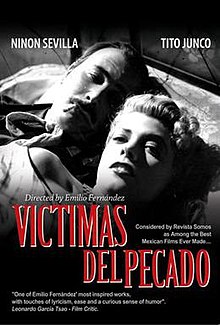Víctimas del Pecado (Victims of Sin) is a 1951 Mexican drama film directed by Emilio Fernández and starring Ninón Sevilla.[1] It was shot at the Churubusco Studios in Mexico City.
| Vìctimas del Pecado | |
|---|---|
 | |
| Directed by | Emilio Fernández |
| Written by | Emilio Fernández Mauricio Magdaleno |
| Produced by | Guillermo Calderòn Pedro Calderòn |
| Starring | Ninón Sevilla Rodolfo Acosta Tito Junco Rita Montaner |
| Cinematography | Gabriel Figueroa |
| Edited by | Gloria Schoemann |
| Music by | Antonio Díaz Conde |
| Distributed by | Cinematográfica Calderón SA |
Release date |
|
Running time | 90 minutes |
| Country | México |
| Language | Spanish |
Detroit Institute of Arts considers the film as "one of the most famous post-war Mexican films," and shares that it includes "knockout mambo numbers by Pérez Prado and Pedro Vargas".[2] The film was also released as Hell's Kitchen.[3]
Plot
editVioleta (Ninón Sevilla), a Cuban dancer from the Cabaret Changó, rescues an infant from a garbage can in Mexico City's red-light district. She decides to raise the baby but this displeases Rodolfo (Rodolfo Acosta), the club's owner. Santiago (Tito Junco), a rival club owner, falls in love with Violeta and offers his help. Tragedy takes place when Rodolfo (Rodolfo Acosta) kills Santiago and is then killed by Violeta.
Cast
edit- Ninón Sevilla as Violeta
- Tito Junco as Santiago
- Rodolfo Acosta as Rodolfo
- Rita Montaner as Rita
- Arturo Soto Rangel as Director de prisión
- Francisco Reiguera as Don Gonzalo
- Lupe Carriles as Doña Longina
- Ismael Pérez as Juanito
- Margarita Ceballos as Rosa
Recognition
editAwards and nominations
edit- 1952, Mexican Academy of Film Ariel Awards nomination for Best Cinematography for Gabriel Figueroa[4]
- 1952, Mexican Academy of Film Ariel Awards nomination for Best Child Actor for Ismael Pérez[4]
Reception
editTwitch Film felt the film would be a perfect match to be double-billed with Josef von Sternberg's Blonde Venus.[5]
Without imagining they were on the verge of securing international fame with the film cabaret series performed by Ninon Sevilla, the Calderon Brothers contracted to Emilio Fernández to direct this musical melodrama that would be more intense and exacerbated that Salón Mexico (1948), the previous raid of "El Indio" into the cabaret environments of the Mexican capital.
As in Salon Mexico, Victimas del Pecado demonstrated the joy of the director in a very particular direct scenes that take place in the cabaret. Also, the director does not hide his love of uplifting moral, nor can he avoid some moments of unintentional comedy as one in which the "Pachuco" Rodolfo Acosta shows his ability to speak more than one language while teaching him how to walk with style to a French prostitute. Despite its considerable shortcomings, Victimas del pecado has kept pace in the filmography of "El Indio" Fernández and the passage of time has not been treated so poorly. Figueroa's photography continues to be splendid and as representative of the filmography of Ninon Sevilla is important to note that the film won an unprecedented success in France and Belgium, where he was known as Quartier interdit (Forbidden Neighborhood or Hell's Kitchen).[6]
Ninon was unsurpassed as the flower that falls in the mud, the star that travels in rotten environments, even though she retains a heart of gold for delivery to a pariah, a hero or a stranger which a past unknown. Could be brave and help to her man, and betray to the gangster that had knocked on his networks. It could also infatuated with someone of the opposite sex, amazed at her honesty, and the love he feels for his adopted son. All this happens in Victimas del Pecado.[7]
References
edit- ^ Rivera, Jacqueline Rush. "Victimas Del Pecado (Victims of Sin)". Cine Las Americas. Retrieved February 3, 2013.
- ^ "Victimas Del Pecado (Victims of Sin)". Detroit Film Theatre. Retrieved February 3, 2013.
- ^ Hal Erickson. "Quartier Interdit (1952)". Movies & TV Dept. The New York Times. Baseline & All Movie Guide. Archived from the original on February 16, 2013. Retrieved February 4, 2013.
- ^ a b "1952 Ariel Award nominees" (in Spanish). Academia Mexicana de Cine. Retrieved February 3, 2013.
- ^ Guillen, Michael (February 3, 2013). "JOSEF VON STERNBERG: EROS AND ABSTRACTION—BLONDE VENUS (1932)". Twitch Film. Retrieved February 16, 2009.
- ^ Víctimas del pecado in the page of the Mexican Cinema of the ITESM
- ^ "Las Rumberas del Cine Mexicano". SOMOS: 63–64. November 1999.
Further reading
edit- De la Mora, Sergio (January 28, 2009). Cinemachismo: Masculinities and Sexuality in Mexican Film. Austin: University of Texas Press. pp. 48–57. ISBN 978-0-292-71296-6. Analysis of performances in Víctimas del Pecado.